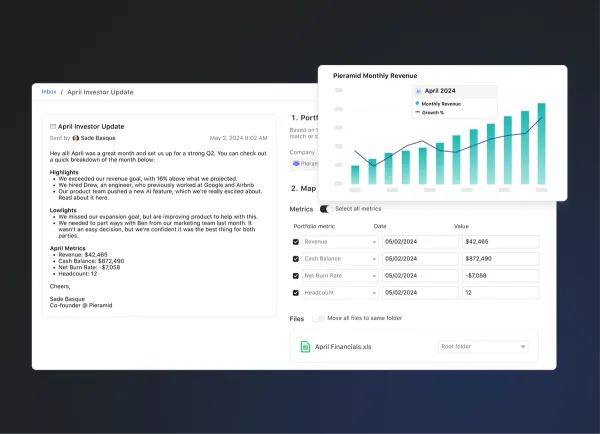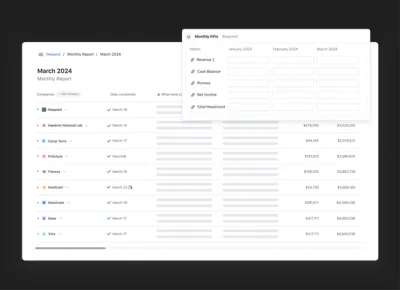
Discounted Cash Flow (DCF) Analysis: The Purpose, Formula, and How it Works

A Discounted Cash Flow (DCF) analysis is a powerful tool for investors to assess the value of a company or investment by projecting future cash flows and discounting them to their present value. This approach allows venture capitalists to identify promising startups, considering their growth potential and market conditions. In this guide, you'll discover the essentials of DCF analysis, how it differs from other valuation methods, and a detailed, step-by-step approach to conducting one. By mastering DCF, you'll gain valuable insights into determining an investment's intrinsic worth and making smarter investment decisions.
What is the Purpose of DCF Analysis?
DCF analysis serves as a cornerstone of financial valuation, especially in the venture capital arena. It enables investors to estimate the present value of an investment based on its expected future cash flows, adjusted for risk and the time value of money. DCF analysis is crucial for venture capitalists because it provides a detailed, quantitative assessment of a startup's financial health and growth prospects. By using DCF, investors can determine whether the potential returns of a startup justify the inherent risks of investing in early-stage companies.
DCF vs. NPV
While both DCF and Net Present Value (NPV) are methods used to assess the value of future cash flows, they serve slightly different purposes and are related yet distinct concepts. DCF is the process of forecasting what an investment's cash flows would be worth in today's money, giving a holistic view of future profitability adjusted for the time value of money. NPV, on the other hand, is a direct outcome of the DCF analysis, representing the difference between the present value of cash inflows and outflows. NPV tells you whether an investment will yield a profit or loss by comparing the initial investment to the DCF. It is particularly valuable in decision-making processes, helping investors weigh the profitability of different investment opportunities.
What Is the DCF Formula?
The DCF formula is used to estimate the value of an investment by predicting its future cash flows and discounting them to their present value. Here's the formula:
- CF (Cash Flows): These are the projected cash flows that the investment is expected to generate over each period (1,2,3,n). Cash flows can include revenue minus operating expenses, taxes, and changes in working capital.
- r (Discount Rate): This represents the rate of return required to make the investment worthwhile, often calculated as the Weighted Average Cost of Capital (WACC). The discount rate accounts for the risk and time value of money, reflecting the riskiness of the projected cash flows.
What Does the DCF Formula Tell You?
The DCF formula provides a method for valuing an investment based on its intrinsic value. By discounting future cash flows to their present value, the DCF formula helps investors determine whether the current price of an investment reflects its true value. This approach allows investors to:
- Assess Profitability: Determine if an investment is likely to yield a return that meets or exceeds the required rate of return.
- Compare Investments: Evaluate multiple investment opportunities to see which one offers the best value relative to its price and risk.
- Make Informed Decisions: Use quantitative data to support investment choices, helping to minimize risks and maximize returns.
How to Conduct a DCF Analysis
Conducting a DCF analysis involves several key steps that help investors estimate the intrinsic value of an investment. This process requires careful planning, detailed financial data, and precise calculations to ensure accuracy. Below is a step-by-step guide on how to perform a DCF analysis, from gathering information to interpreting the results.
1. Gather Information
The first step in conducting a DCF analysis is to collect all necessary financial data and relevant information about the company. This includes:
- Financial Statements: Obtain the company’s income statements, balance sheets, and cash flow statements. These documents provide historical financial data that is crucial for making accurate projections.
- Market Research: Conduct research on the market and industry in which the company operates. This includes understanding the competitive landscape, regulatory environment, and macroeconomic factors.
- Company-Specific Information: Gather detailed information about the company’s operations, business model, growth strategy, and management team. This helps in making realistic assumptions about future performance.
2. Forecast Future Cash Flows (FCF)
Projecting future cash flows is a critical step in the DCF analysis. This involves:
- Analyzing Historical Data: Use historical financial data to identify trends and patterns in the company’s performance.
- Making Assumptions: Develop assumptions about future revenue growth, operating expenses, capital expenditures, and working capital needs. These assumptions should be based on historical trends, industry benchmarks, and market conditions.
- Projecting Cash Flows: Forecast the company’s free cash flows (FCF) for a specific period, typically 5 to 10 years. Free cash flow is calculated as operating cash flow minus capital expenditures.
3. Determine the Discount Rate (WACC)
The discount rate used in a DCF analysis is typically the Weighted Average Cost of Capital (WACC). Calculating WACC involves:
- Cost of Equity: Estimate the cost of equity using models like the Capital Asset Pricing Model (CAPM), which considers the risk-free rate, beta (a measure of stock volatility), and market risk premium.
- Cost of Debt: Determine the cost of debt by assessing the interest rates on the company’s outstanding debt, adjusted for tax savings.
- Weighting: Calculate the weighted average of the cost of equity and cost of debt based on their proportions in the company’s capital structure.
4. Estimate the Terminal Value (TV)
Terminal value accounts for the value of cash flows beyond the forecast period. There are two common methods to calculate TV, the Perpetuity Growth Model and Exit Multiple Method.
Industry professionals often favor the exit multiple approach because it allows them to compare the business's value to observable market data. In contrast, academics tend to prefer the perpetual growth model due to its strong theoretical basis. Some practitioners opt for a hybrid method, combining both approaches to arrive at a more balanced valuation.
- Perpetuity Growth Model: The perpetual growth method is widely favored by academics for calculating terminal value due to its solid mathematical foundation. This approach assumes that a business will continue to generate Free Cash Flow (FCF) indefinitely at a stable, normalized rate. This model captures the ongoing value of a company's cash flows beyond the forecast period, reflecting a perpetuity scenario.
TV is calculated as:
TV = (FCFn x (1 + g)) / (WACC – g)
Where:
- TV = terminal value
- FCF = free cash flow
- n = year 1 of terminal period or final year
- g = perpetual growth rate of FCF
- WACC = weighted average cost of capital
- Exit Multiple Method: The exit multiple approach estimates the terminal value by assuming the business can be sold at a multiple of a certain financial metric, such as EBITDA. This multiple is determined based on the trading multiples observed for similar businesses in the market.
The formula for calculating the exit multiple terminal value is:
TV = Financial Metric (e.g., EBITDA) x Trading Multiple (e.g., 10x)
5. Calculate the Present Value (PV)
Discounting the forecasted cash flows and terminal value to their present value is a critical step in the DCF analysis. This process involves applying a discount rate to each projected cash flow and the terminal value to reflect their value in today's terms. Here’s how you can do it both mathematically and conceptually:
- Present Value of Cash Flows: Calculate the present value of each projected cash flow using the formula
PV= CFt / (1+r)ₜ
Where:
- PV = Present Value
- CFt = Cash Flow in period t
- r = Discount rate (often the Weighted Average Cost of Capital, WACC)
- t = Time period (year)
- Present Value of Terminal Value: Discount the terminal value back to its present value using TV / (1+r)ₙ
- Total DCF Value: Sum the present values of the projected cash flows and the terminal value to obtain the total DCF value.
6. Interpret the Results
Analyzing the results of the DCF analysis involves:
- Comparing to Current Market Value: Compare the calculated DCF value to the company’s current market value to determine if the investment is undervalued or overvalued.
- Sensitivity Analysis: Assess how changes in key assumptions (e.g., growth rates, discount rate) impact the DCF value. This helps in understanding the sensitivity of the valuation to different scenarios.
- Making Investment Decisions: Use the DCF valuation to make informed investment decisions, considering both the potential risks and returns.
Related resource: Valuing Startups: 10 Popular Methods
Advantages of DCF Analysis
Understanding the advantages of a DCF analysis is crucial for investors. By providing a comprehensive evaluation of an investment's potential, DCF helps investors make well-informed decisions to maximize returns and manage risks effectively. This method provides a robust framework for evaluating investments by focusing on future cash flows and intrinsic value. Here are some key advantages of using DCF analysis.
Intrinsic Value
DCF analysis provides an estimate of the intrinsic value of an investment by focusing on the underlying cash flows. This approach is independent of current market conditions, making it a more reliable indicator of an investment's true worth. By projecting future cash flows and discounting them to their present value, investors can assess whether an investment is undervalued or overvalued relative to its intrinsic worth.
Future-Oriented
One of the significant benefits of DCF analysis is its forward-looking nature. Unlike other valuation methods that rely heavily on historical performance, DCF considers expected future cash flows. This makes it particularly useful for assessing the future potential of an investment, especially in dynamic or rapidly growing industries. By focusing on future cash flows, DCF helps investors make more informed decisions based on the expected performance of the investment.
Flexibility
DCF analysis offers considerable flexibility in making assumptions about future growth rates, discount rates, and cash flow projections. This adaptability allows investors to model various scenarios and understand how different assumptions impact the investment's valuation. Whether it's adjusting for optimistic or conservative growth forecasts, DCF can accommodate a wide range of scenarios, providing a comprehensive view of potential outcomes.
Detailed Insight
By breaking down the valuation into its components—cash flows, discount rate, and terminal value—DCF analysis provides detailed insights into what drives the value of an investment. This granularity helps investors understand the key factors influencing the investment's valuation and identify potential risks and opportunities. DCF allows for a deeper analysis of the financial health and future prospects of the investment, aiding in more strategic decision-making.
Limitations of a DCF Analysis
While DCF analysis is a valuable tool for investment valuation, it comes with limitations that investors must consider. The sensitivity to assumptions, complexity of financial modeling, and challenges in forecasting future cash flows highlight the importance of careful and informed analysis when using DCF to value investments. By being aware of these limitations, investors can better navigate the intricacies of DCF and make more reliable investment decisions.
Sensitivity to Assumptions
DCF valuations are highly sensitive to the assumptions made about growth rates, discount rates, and future cash flows. Small changes in any of these variables can significantly alter the valuation outcome. For example, a slight increase or decrease in the discount rate can have a substantial impact on the present value of future cash flows, leading to vastly different valuations. This sensitivity requires investors to be cautious and thorough when making assumptions and to consider a range of scenarios to understand the potential variability in the valuation.
Complexity
The DCF method requires detailed financial modeling and a deep understanding of the business being evaluated. This complexity can be time-consuming and may not be accessible to all investors, particularly those without a strong financial background. Accurate DCF analysis demands precise data, robust financial models, and a clear grasp of the industry dynamics, which can be challenging to achieve. This complexity often means that DCF analysis is best performed by experienced professionals or with the assistance of financial experts.
Forecasting Challenges
Accurately forecasting future cash flows is inherently difficult, especially for new or rapidly evolving industries. The further out the forecast period extends, the greater the uncertainty becomes. This challenge is exacerbated in industries with high volatility, where predicting future performance can be fraught with uncertainty. Inaccurate or overly optimistic forecasts can lead to misleading valuations, making it crucial for investors to base their projections on realistic and well-researched assumptions.
Leveraging DCF Analysis with Visible for Informed Investment Decisions
DCF analysis is an essential tool for investors, offering a robust framework to evaluate the intrinsic value of investments by focusing on future cash flows. This guide has explored the significance of DCF in venture capital, detailed the formula and steps to perform a DCF analysis, and highlighted both its advantages and limitations. By mastering DCF analysis, investors can make more informed decisions, assessing the true potential of their investments and mitigating risks effectively.
For startups and investors seeking detailed insights and efficient financial tracking, Visible provides a comprehensive platform to streamline your investment processes.
Learn how to get started with Visible to track your crucial investment data here.
Related resources:



